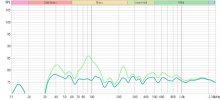why did this work out so well for me, despite going against the conventional wisdom of room EQ?
So, in theory, a "true" null is where a sound wave bounces back and cancels itself out completely. 2 - 2 = 0. This is where the big dips come from.
In this case, you can't EQ it and you'll only cause problems if you try, because 4 - 4 = 0 too. Boosting does nothing to the null.
In practice, "true" nulls are rare because sound doesn't reflect or cancel perfectly, it bounces off irregular surfaces randomly, you have multiple speakers spaced out by a significant fraction of the wavelengths in question, etc. Also, even if you do have true nulls, or close to it, you might not actually be sitting in one... just near one.
So, in practice, EQing the dips does work to some extent. I've had the same experience myself.
However, it can be problematic even if your measurements look better.
Where there are nulls, there can also be peaks. So if noise spreading to your neighbors or throughout the house is a concern, you just added a few dB to that problem.
You can also run out of amp power / speaker excursion pretty easily when you boost nulls in the bass. You would need to add AT LEAST 10dB to pull up that dip at 65hz. Unless you actually have 10dB of power and excursion to spare at that frequency, you're going to have a bad time. Most systems have just enough bass output to get by. It's the most difficult and expensive part of a speaker system. So demanding 2-10x from the bass is often a nonstarter.
I'm personally in favor of EQing dips YOLO style, but you need to know what you're doing. I would also not do it unless I had at least one sub in action, since in that case you get A) more headroom / SPL capability and B) a better chance of not having "true" nulls.

